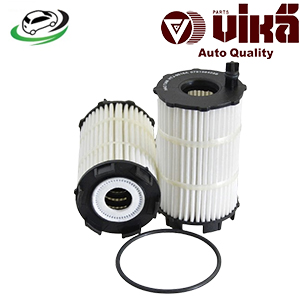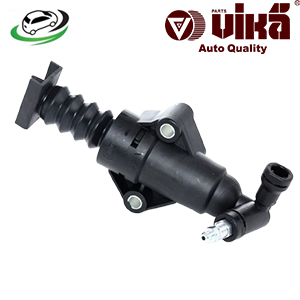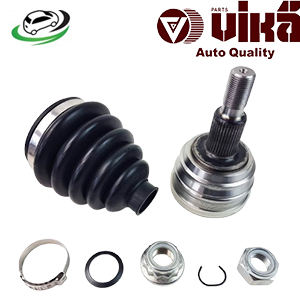-9%
Get Front Outer CV Joint & Boot Kit AUDI A3 8L 1.6 / VW Golf MK4 1J-1.4/1.6/1.9 TDI/Bora 1J-1.4/1.6/1.9 TDI/Beetle 1C-1.4 1J0498099A
The outer CV (Constant Velocity) joint and boot kit are essential components in a vehicle’s drivetrain, particularly in front-wheel-drive and all-wheel-drive vehicles. These components play a critical role in transferring power from the transmission to the wheels while allowing for smooth rotation and steering. In this comprehensive guide, we will explore the design, function, types, common issues, and maintenance of outer CV joints and boot kits.
Design and Function
Outer CV Joint:
- Structure:
- Inner and Outer Races: The outer CV joint consists of an inner race, an outer race, and a set of ball bearings. The inner race is connected to the axle shaft, while the outer race is connected to the wheel hub. The ball bearings are held in place by a cage, allowing them to move freely within the races.
- Ball Bearings: The ball bearings are positioned in grooves within the races, enabling them to transmit torque from the axle to the wheel while allowing for the necessary range of motion. These grooves are designed to ensure that the balls remain evenly spaced and can move smoothly in response to changes in the angle of the joint.
- Housing: The entire assembly is enclosed within a sturdy metal housing that provides protection against external elements, such as dirt, moisture, and debris. This housing is often referred to as the “joint case” or “outer housing.”
- Functionality:
- Power Transmission: The primary function of the outer CV joint is to transfer power from the transmission to the wheels while accommodating the up-and-down motion of the suspension and the steering angles. This ensures that the vehicle can maintain traction and control, even when the wheels are turning or the suspension is moving.
- Flexibility: The outer CV joint allows for a greater range of motion compared to other types of joints, such as universal joints. This flexibility is crucial for front-wheel-drive vehicles, where the front wheels are responsible for both steering and power transmission.
- Smooth Operation: The ball bearings within the CV joint enable smooth and efficient power transfer, minimizing friction and reducing wear on the drivetrain components. This contributes to a quieter and more comfortable driving experience.
CV Boot:
- Structure:
- Rubber or Neoprene Material: The CV boot is typically made of durable rubber or neoprene, materials that are flexible yet resistant to wear, heat, and environmental factors. This material choice ensures that the boot can withstand the harsh conditions of the road while maintaining its integrity over time.
- Accordion Design: The boot is designed with an accordion-like structure, allowing it to expand and contract as the CV joint moves. This design provides the necessary flexibility to accommodate the joint’s range of motion without compromising the boot’s protective function.
- Clamps and Fasteners: The CV boot is secured to the axle shaft and the joint housing using metal clamps or bands. These fasteners ensure a tight seal, preventing contaminants from entering the joint and retaining the lubricating grease inside.
- Functionality:
- Protection: The primary function of the CV boot is to protect the CV joint from dirt, moisture, and debris. By sealing the joint, the boot prevents contaminants from entering and causing damage to the bearings and races. This protection is crucial for maintaining the longevity and performance of the CV joint.
- Lubrication Retention: The CV boot also retains the lubricating grease within the joint. This grease is essential for reducing friction and wear between the moving parts of the joint, ensuring smooth operation and preventing premature failure.
- Flexibility: The accordion design of the boot allows it to flex and move with the joint, accommodating the various angles and movements of the axle shaft. This flexibility is key to maintaining the boot’s protective function while allowing the joint to perform its necessary tasks.
Types of Outer CV Joints
- Rzeppa CV Joint:
- Design: The Rzeppa joint is the most common type of outer CV joint, particularly in front-wheel-drive vehicles. It features six ball bearings that sit in grooves in the inner and outer races, allowing for a wide range of motion.
- Applications: Rzeppa joints are typically used in the front axles of vehicles, where they provide the necessary flexibility for both steering and suspension movement. They are known for their durability and smooth operation.
- Tripod CV Joint:
- Design: The tripod joint, also known as a “tri-lobe” joint, features three roller bearings mounted on trunnions that are attached to the axle shaft. These rollers move within a housing that is shaped like a “cup,” allowing for axial movement while transmitting torque.
- Applications: Tripod joints are commonly used in the inner CV joint position, but they can also be found in some outer CV joints. They are often used in applications where a high degree of axial movement is required, such as in the driveshafts of some vehicles.
- Double Cardan Joint:
- Design: The double Cardan joint is essentially two universal joints mounted back-to-back. This design allows for greater flexibility and a higher angle of operation compared to a single universal joint.
- Applications: While not as common as Rzeppa or tripod joints, double Cardan joints are used in some specialized applications, such as in the front axles of certain off-road vehicles where extreme articulation is required.
Common Issues with Outer CV Joints and Boots
- Boot Damage:
- Tears and Cracks: The CV boot is subject to wear and tear over time, particularly due to exposure to road debris, extreme temperatures, and the constant flexing of the joint. Tears and cracks in the boot can allow contaminants to enter the joint and grease to escape, leading to joint damage.
- Degradation: Over time, the rubber or neoprene material of the boot can degrade due to exposure to UV rays, ozone, and chemicals. This can cause the boot to become brittle and more prone to cracking.
- Grease Leakage:
- Loss of Lubrication: If the CV boot is damaged or improperly sealed, the lubricating grease can leak out, leaving the joint without adequate lubrication. This can lead to increased friction, heat, and wear within the joint, ultimately causing it to fail.
- Visible Grease Splatter: One of the signs of a leaking CV boot is visible grease splatter on the inside of the wheel or along the suspension components. This indicates that the boot is no longer effectively containing the grease.
- Joint Wear and Failure:
- Contaminant Ingress: When the CV boot is compromised, dirt, moisture, and other contaminants can enter the joint, leading to corrosion, pitting, and accelerated wear of the bearings and races. Over time, this can cause the joint to fail, resulting in a loss of power to the wheel and potentially leaving the vehicle inoperable.
- Noise and Vibration: As the CV joint wears, it can develop play or looseness, leading to clicking, popping, or clunking noises during turns, especially when accelerating. Vibration felt through the steering wheel or the vehicle’s chassis is another common symptom of a failing CV joint.
Maintenance and Replacement
- Regular Inspection:
- Visual Checks: Regular visual inspections of the CV boots should be part of routine vehicle maintenance. Look for signs of cracks, tears, or grease leakage. If any damage is detected, the boot should be replaced as soon as possible to prevent further damage to the CV joint.
- Checking for Noise: Pay attention to any unusual noises when turning the vehicle, particularly clicking or popping sounds. These can be early warning signs of CV joint wear and may indicate that the joint needs to be inspected or replaced.
- Boot Replacement:
- Timely Replacement: If a CV boot is found to be damaged, it should be replaced promptly to prevent dirt and moisture from entering the joint. In many cases, replacing the boot and repacking the joint with fresh grease can extend the life of the CV joint.
- Boot Kits: CV boot kits are available that include a new boot, clamps, and grease. These kits make it easier to perform a boot replacement, ensuring that all the necessary components are included.
- Joint Replacement:
- Complete Replacement: If the CV joint is already worn or damaged, replacing the entire joint may be necessary. This typically involves removing the axle shaft from the vehicle and replacing the outer CV joint assembly.
- Quality Parts: When replacing a CV joint, it’s important to use high-quality parts that meet or exceed the manufacturer’s specifications. This ensures that the new joint will provide reliable performance and longevity.
- Preventive Maintenance:
- Regular Grease Inspection: Ensuring that the CV joint is properly lubricated is essential for preventing wear. If the boot is intact but the grease inside has degraded or been contaminated, the joint should be cleaned and repacked with fresh grease.
- Protective Measures: In some cases, additional protective measures, such as installing protective covers or shields, can help extend the life of the CV boots, especially in vehicles that are regularly driven in harsh conditions.
Follow us on Facebook for more parts.



